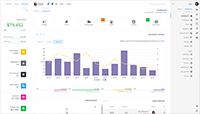Ericsson University
Sara Hopkins
Webdeveloper
Statistics
$545
27%
Introduction
Introduction
We’ve created this admin panel for everyone who wants to create any templates based on our ready components. Our mission is to deliver a user-friendly,clear and easy administration panel,that can be used by both,simple websites and sophisticated systems. The only requirement is a basic HTML and CSS knowledge—as a reward,you’ll be able to manage and visualize different types of data in the easiest possible way!
puffin is a popular open source WebApp template for admin dashboards and admin panels. It’s responsive HTML template,which is based on the Bootstrap 4X framework. It utilizes all of the Bootstrap components in design and re-styles many commonly used plugins to create a consistent design that can be used as a user interface for backend applications.
puffin is based on a modular design,which allows it to be easily customised and built upon any backend project in no-time. Our documentation will guide you through installing the template and exploring the various components that are bundled with the template.
Grunt File & Installation
The JavaScript Task Runner.Installing Grunt:Run npm install grunt --save-devcommand from your teminal to install grunt within your project.
Grunt Sass:Run grunt sasscommand from your project directory. It will compile SASS to CSS for the project. This will read the file `assets/scss/filename.scss` and output a plain-css file to `/assets/css/filename.css`.
Grunt JSHint:Run grunt jshintcommand from your project directory. It will checks all *.js files under `assetsjs/filename` for common syntax or coding errors using the JSHint utility.
Grunt Sprite:Run grunt spritecommand from your project directory.
Further help:To get more help on the grunt checkout Grunt
Note:However,any SASS code you write must be able compile via Grunt as well.It will generate pre-compiled javascript templates.
Gruntis a JavaScript task runner,a tool used to automatically perform frequent tasks such as minification,compilation,unit testing,and linting. It uses a command-line interface to run custom tasks defined in a file.
SCSS Structure
Before you can use Sass,you need to set it up on your project. If you want to just browse here,go ahead,but we recommend you go install Sass first. Go hereif you want to learn how to get everything setup.
Folder Structure
HTML/├──assets├──bundles/├──css/├──fonts/├──images/├──js/├──plugins/├──sass/├──dark├──assets├──css/├──js/├──HTML├──doc├──horizontal├──assets├──css/├──js/├──HTML├──light├──assets├──css/├──js/├──HTML├──rtl├──assets├──css/├──js/├──HTML├──theme1├──assets├──css/├──js/├──HTML├──theme2├──assets├──css/├──js/├──HTML
Font Used
Google fonts are used in the template. They are as follows:Source Sans Pro
Font Awesome:Click to See
All Images are used:Pexels.com



 English
English Spanish
Spanish japanese
japanese France
France